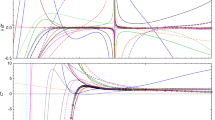Abstract
The spin-1 Ising model, which is equivalent to the three-component lattice gas model, is used to study wetting transitions in three-component surfactant systems consisting of an oil, water, and a nonionic surfactant. Phase equilibria, interfacial profiles, and interfacial tensions for three-phase equilibrium are determined in mean field approximation, for a wide range of temperature and interaction parameters. Surfactant interaction parameters are found to strongly influence interfacial tensions, reducing them in some cases to ultralow values. Interfacial tensions are used to determine whether the middle phase, rich in surfactant, wets or does not wet the interface between the oil-rich and water-rich phases. By varying temperature and interaction parameters, a wetting transition is located and found to be of the first order. Comparison is made with recent experimental results on wetting transitions in ternary surfactant systems.
Similar content being viewed by others
References
J. K. Percus,J. Stat. Phys. 47:801 (1987).
S. Dietrich, inPhase Transitions and Critical Phenomena, Vol. 12, C. Domb and J. L. Lebowitz, eds. (Academic Press, New York, 1988), p. 1.
D. E. Sullivan and M. M. Telo da Gama, inFluid Interfacial Phenomena, C. A. Croxton, ed. (Wiley, New York, 1985), p. 45.
Y. Seeto, J. E. Puig, L. E. Scriven, and H. T. Davis,J. Colloid Interface Sci. 96:360 (1983).
J. C. Lang and B. Widom,Physica A 81:190 (1975).
M. Kahlweit, R. Strey, P. Firman, D. Haase, J. Jen, and R. Schomacker,Langmuir 4:499 (1988).
M. Kahlweit and G. Busse,J. Chem. Phys. 91:1339 (1989).
M. Robert and J. F. Jeng,J. Phys. (Paris)49:1821 (1988).
L. J. Chen, J. F. Jeng, M. Robert, and K. P. Shukla,Phys. Rev. A 42:4716 (1990).
G. N. Antonow,J. Chim. Phys. 5:372 (1907);Kolloid-Z. 9:7 (1932);64:336 (1933).
N. K. Adam,The Physics and Chemistry of Surfaces, 3rd ed. (Oxford University Press, 1941), pp. 7, 214–215.
F. Neumann, inVorlesungen über die Theorie der Kapillaritat, A. Wangerin, ed. (Teubner, Leipzig, 1894), Chapter 6, Section 1, pp. 161–162.
F. P. Buff and H. Saltsburg,J. Chem. Phys. 26:23 (1957).
F. B. Buff, inEncyclopedia of Physics, S. Flugge, ed. (Springer, Berlin, 1960), Vol. 10, Section 7, pp. 298–299.
Y. Tolman and S. Prager,J. Chem. Phys. 69:2984 (1978); J. Jouffry, P. Levinson, and P. G. de Gennes,J. Phys. (Paris)43:1241 (1982).
B. Widom,J. Chem. Phys. 81:1030 (1984).
S. A. Safran, D. Roux, and M. E. Cates and D. Andelmann,Phys. Rev. Lett. 57:491 (1986).
W. R. Rossen, R. G. Brown, H. T. Davis, S. Prager, and L. E. Scriven,Soc. Petroleum Eng. J. 22:945 (1982); M. Kahlweit, R. Strey, and G. Busse,J. Phys. Chem. 94:3881 (1990).
B. Widom,J. Chem. Phys. 84:6943 (1986).
J. C. Wheeler and B. Widom,J. Am. Chem. Soc. 90:3064 (1968); J. C. Wheeler,J. Chem. Phys. 62:433 (1975); A. Robledo,Eur. Lett. 1:303 (1986).
T. P. Stockfisch and J. C. Wheeler,J. Phys. Chem. 92:3292 (1988).
K.-A. Dawson,Phys. Rev. A 35:1766 (1987).
K. A. Dawson, B. L. Walker, and A. Berera,Physica A 165:320 (1990).
M. Schick and W.-H. Shih,Phys. Rev. B 34:1797 (1986);Phys. Rev. Lett. 59:1205 (1987).
G. Gomper and M. Schick,Phys. Rev. Lett. 62:1647 (1989);Phys. Rev. B 41:9148 (1990).
K. Chen, C. Ebner, C. Jayaprakash, and R. Pandit,J. Phys. C 20:L361 (1987).
A. Ciach, J. S. Hoye, and G. Stell,J. Chem. Phys. 90:1214 (1989).
A. Ciach and J. S. Hoye,J. Chem. Phys. 90:1222 (1989).
M. Blume, V. Emery, and R. B. Griffiths,Phys. Rev. A 4:1071 (1971); D. Mukamel and M. Blume,Phys. Rev. A 10:610 (1974); see also D. Furman, S. Dattagupta, and R. B. Griffiths,Phys. Rev. B 15:441 (1977).
M. Kahlweit, R. Strey, and J. Jen, inProgress in Microemulsions, S. Martellucci and A. N. Chester, eds. (Plenum Press, New York, 1989), p. 61.
G. Gomper and M. Schick,Phys. Rev. Lett. 65:116 (1990); in Proceedings of the ACS Symposium “Fundamental Properties of Interfaces in Simple and Complex Fluids,” Boston, April 1990,Physica A 172:200 (1991).
O. Abillon, L. T. Lee, D. Langevin, and K. Wong, in Proceedings of the ACS Symposium “Fundamental Properties of Interfaces in Simple and Complex Fluids,” Boston, April 1990,Physica A 172:209 (1991).
L. M. Trejo, J. Gracia, C. Varea, and A. Robledo,Europhys. Lett. 7:537 (1988).
Author information
Authors and Affiliations
Additional information
This paper is dedicated to J. K. Percus in honor of his 65th birthday.
Rights and permissions
About this article
Cite this article
Shukla, K.P., Payandeh, B. & Robert, M. Theory of interfacial phase transitions in surfactant systems. J Stat Phys 63, 1053–1075 (1991). https://doi.org/10.1007/BF01029999
Received:
Issue Date:
DOI: https://doi.org/10.1007/BF01029999




